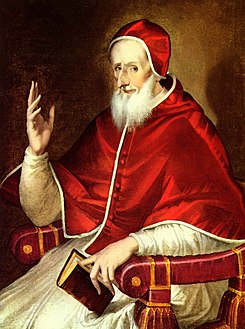St. Pius V
|
Pope Saint Pius V |
|
|---|---|
| Bishop of Rome | |
 |
|
| Papacy began | 7 January 1566 |
| Papacy ended | 1 May 1572 |
| Predecessor | Pius IV |
| Successor | Gregory XIII |
| Orders | |
| Ordination | 1528 |
| Consecration | 14 September 1556 by Giovanni Michele Saraceni |
| Created Cardinal | 15 March 1557 by Pope Paul IV |
| Personal details | |
| Birth name | Antonio Ghislieri |
| Born |
17 January 1504 Bosco, Duchy of Milan |
| Died | 1 May 1572 (aged 68) Rome, Papal States |
| Previous post |
|
| Motto | Utinam dirigantur viæ meæ ad custodiendas justificationes tuas (O that my ways may be directed to keep thy justifications) |
| Coat of arms |  |
| Sainthood | |
| Feast day |
|
| Venerated in | Roman Catholic Church |
| Beatified | 1 May 1672 by Pope Clement X |
| Canonized | 22 May 1712 by Pope Clement XI |
| Attributes |
|
| Patronage |
|
|
Papal styles of Pope Pius V |
|
|---|---|
 |
|
| Reference style | His Holiness |
| Spoken style | Your Holiness |
| Religious style | Holy Father |
| Posthumous style | Saint |
Pope Saint Pius V (17 January 1504 – 1 May 1572), born Antonio Ghislieri (from 1518 called Michele Ghislieri, O.P.), was Pope from 8 January 1566 to his death in 1572. He is venerated as a saint of the Roman Catholic Church. He is chiefly notable for his role in the Council of Trent, the Counter-Reformation, and the standardization of the Roman rite within the Latin Church. Pius V declared Thomas Aquinas a Doctor of the Church.
As a cardinal, Ghislieri gained a reputation for putting orthodoxy before personalities, prosecuting eight French bishops for heresy. He also stood firm against nepotism, rebuking his predecessor Pope Pius IV to his face when he wanted to make a 13-year-old member of his family a cardinal and subsidize a nephew from the papal treasury.
By means of the papal bull of 1570, Regnans in Excelsis, Pius V excommunicated Elizabeth I of England for heresy and persecution of English Catholics during her reign. He also arranged the formation of the Holy League, an alliance of Catholic states. Although outnumbered, the Holy League famously defeated the Ottoman Empire, which had threatened to overrun Europe, at the Battle of Lepanto. Pius V attributed the victory to the intercession of the Blessed Virgin Mary and instituted the feast of Our Lady of Victory. Biographers report that as the Battle of Lepanto ended, Pius rose and went over to a window, where he stood gazing toward the East. Then, turning around, he exclaimed "The Christian fleet is victorious!" and shed tears of thanksgiving.
...
Wikipedia
